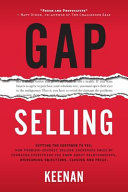

Gap Selling revolves around the concept of identifying and understanding the gap between a customer's current state and their desired future state. This gap is crucial for sales professionals to comprehend, as it highlights the challenges and obstacles the customer faces. By focusing on the gap, sellers can tailor their approach to address specific pain points and demonstrate how their product or service can bridge this gap. The emphasis is on the importance of asking the right questions to uncover the underlying issues that the customer may not even be aware of. This understanding allows for a more personalized sales approach that resonates with the customer's needs.
Continue readingIn Gap Selling, diagnosis is a critical aspect of the sales process. Just like a doctor must diagnose a patient before prescribing treatment, sales professionals must diagnose the customer's problems before proposing solutions. This involves asking probing questions and actively listening to the customer's responses. The goal is to uncover not just the symptoms of the problem but the root causes. By accurately diagnosing the customer's situation, sellers can position their offerings as the most effective solution to bridge the identified gap. This diagnostic approach fosters trust and credibility, as customers feel understood and valued.
Continue readingGap Selling promotes a value-based selling approach, where the focus is on the value that the product or service brings to the customer rather than just its features or price. This shift in perspective is essential for successful sales, as customers are more likely to invest in solutions that clearly demonstrate how they will improve their current situation. By articulating the value of bridging the gap, sellers can create a compelling narrative that resonates with the customer's aspirations and pain points. This approach encourages sales professionals to develop a deep understanding of the customer's business and to communicate how their solution aligns with the customer's goals.
Continue readingQuestions are a fundamental tool in Gap Selling. The book emphasizes the art of asking the right questions to uncover the customer's needs and challenges. Open-ended questions, in particular, are highlighted as a means to encourage dialogue and exploration. By engaging customers in conversation, sellers can gather valuable insights that inform their sales strategy. The right questions not only reveal the gap but also help customers articulate their needs, leading to a more productive sales interaction. This emphasis on inquiry fosters a collaborative atmosphere, where the seller and customer work together to identify the best path forward.
Continue readingGap Selling underscores the importance of building trust and relationships with customers. In a competitive marketplace, establishing rapport can be a significant differentiator. The book advocates for a consultative selling approach, where the seller acts as a trusted advisor rather than a mere vendor. By demonstrating genuine interest in the customer's challenges and goals, sellers can foster long-term relationships that extend beyond single transactions. This relational focus not only enhances the likelihood of closing deals but also opens doors for future opportunities and referrals, creating a sustainable sales pipeline.
Continue readingObjections are a natural part of the sales process, and Gap Selling provides strategies for effectively managing them. The book encourages sales professionals to view objections as opportunities for deeper understanding rather than as roadblocks. By addressing objections head-on and using them as a springboard for further discussion, sellers can clarify misunderstandings and reinforce the value of their solution. This proactive approach to objections helps maintain momentum in the sales conversation and demonstrates the seller's commitment to finding the best solution for the customer.
Continue readingClosing the sale in Gap Selling is framed as a natural conclusion to a well-executed sales process rather than a high-pressure tactic. The book emphasizes that if the seller has effectively diagnosed the customer's needs, demonstrated value, built trust, and addressed objections, the close should feel like a logical next step. By guiding the customer through the decision-making process and reinforcing the benefits of moving forward, sellers can achieve successful outcomes. This approach aligns with the overall philosophy of Gap Selling, which prioritizes the customer's experience and satisfaction throughout the sales journey.
Continue reading